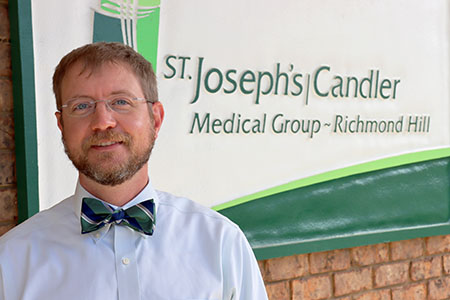Fighting the SADness
Family Health
St. Joseph’s/Candler Primary Care Physician Dr. Russell Lake explains common symptoms of seasonal affective disorder
With winter officially on its way, the drop in temperature and the dwindling of daylight, you may feel SAD. Not just sad, but SAD.
It stands for seasonal affective disorder, and it’s a form of depression that affects millions of Americans each year.
“Seasonal affective disorder is a subtype of an underlying depression disorder, or in some cases bipolar disorder,” explains Dr. Russell Lake, family medicine physician with St. Joseph’s/Candler Primary Care in Richmond Hill. “With this condition, a patient’s depressive symptoms demonstrably follow a cyclical, seasonal pattern each year.”

Many people believe that SAD only affects those in the northern regions of the world, with months of short, cold days and less light. However, your spot on the map is not the determining factor.
“A patient may think, ‘It can’t be seasonal affective disorder. I live in Sun City!’” Dr. Lake says. “But recent studies have shown that a person can suffer from SAD regardless of their latitude. What is crucial is to recognize the cyclical pattern of symptoms.
Common symptoms of SAD include:
- Having decreased or low energy
- Either too much sleep or not enough sleep
- Either increased appetite (especially for carbohydrates) or decreased
- Withdrawal or isolation, often referred to as hibernating
- Feelings of hopeless, worthless or guilt
Dr. Lake has screening tools and other diagnostic criteria to help determine if a patient is experiencing depression and the possible types. Then he can recommend possible treatment options.
“Every patient is different,” Dr. Lake says. “For patients with SAD, we may be able to treat them for only the season in which they are affected. Conversely, common treatments for SAD may not be effective for patients dealing with chronic, year-round depression.”
Tips for beating the winter blues
You can tackle the challenges of SAD head-on with these tips.
Challenge 1: While experts aren’t sure what exactly causes SAD, many believe that seasonal changes disrupt the body’s internal clock, maybe because of limited daylight during the winter.
How to fight it: Talk with your healthcare provider. They may recommend light therapy. This method is used to make up for the lack of natural sunshine during colder days.
“Light therapy is a mainstay for people with fall/winter onset of SAD,” Dr. Lake says.
Challenge 2: People who have SAD experience some of the same symptoms as people with standard depression, including feelings of hopelessness and trouble concentrating.
How to fight it: Focus on positive thoughts and try not to think too much about how you feel. Instead, distract yourself with your favorite hobbies. Talk with your provider if your symptoms continue.
Challenge 3: SAD can give you an increased appetite and a tendency to put on weight.
How to fight it: Push yourself to be more active, even though it may be cold outside. Exercise can boost your mood and help you maintain a weight that’s right for you. Try an indoor workout class online or on TV. Or, rely on housework, such as vacuuming, sweeping or going up and down stairs, to get your blood pumping.
Challenge 4: If you have SAD, you’re likely to oversleep and feel generally sluggish.
How to fight it: Spend time with friends and family and look for ways to get involved in your community, such as volunteering. Socializing can help improve your mood. There’s even some evidence that a lack of social support can worsen depressive symptoms.
“We know these lifestyle habits can help prevent things like heart disease and stroke,” Dr. Lake says. “But a commitment to these smart choices is also generally good for our mental health.”